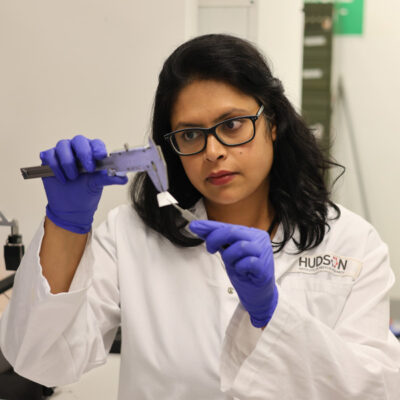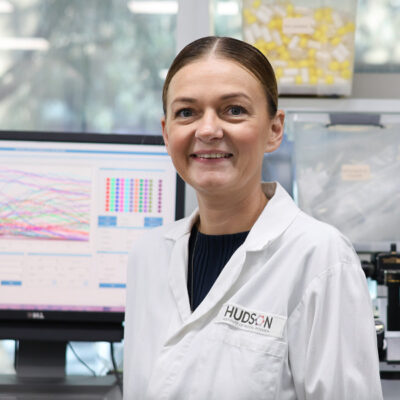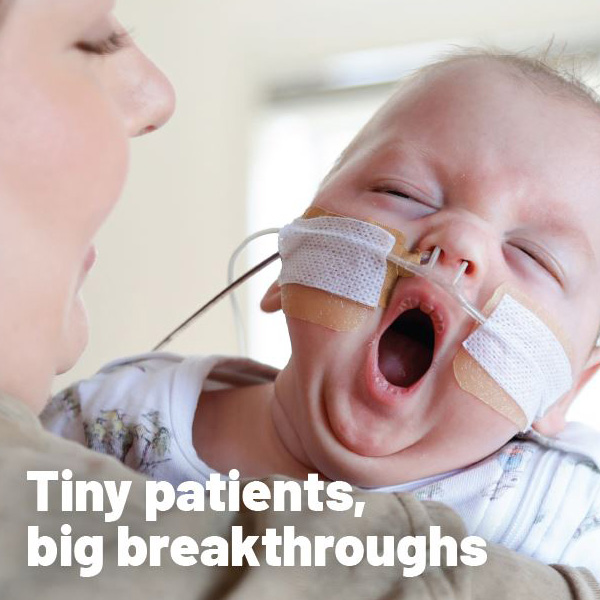Simpler, faster endometriosis diagnosis just got much closer
By Rob Clancy, staff writer. Reviewed by Dr Shanti Gurung

Imagine if it took up to ten years to be diagnosed with asthma or diabetes, and the best hope of a cure was only temporary, via surgery; welcome to the life of an endometriosis sufferer.
For up to one-in-seven women, that is an everyday reality, with endometriosis being just as common as those other two much better-known conditions.
Endometriosis is finally starting to receive the level of public attention it deserves, considering how common and debilitating it is, but two major challenges remain: earlier diagnosis and better treatment.
Professor Caroline Gargett leads a dedicated group of researchers at Hudson Institute working in both these areas, and there has been some exciting news from her lab in recent months.
Simple, painless endometriosis diagnosis
Her team is working to address the diagnosis challenge by finding a way to detect endo sooner and without the need for invasive surgery.
Dr Shanti Gurung is building on the team’s discovery that menstrual fluid could be used as a non-invasive diagnostic, and her latest study, published in the Journal of Extracellular Vesicles, provides major encouragement.
Her project involves measuring and profiling small extracellular vesicles found in menstrual fluid, with the aim of developing a simple diagnostic test, no more complicated than a blood test.
“Extracellular vesicles (EVs) are nano-sized parcels that cells secrete for efficient communication with other cells,” Dr Gurung said. “In this project, we investigated proteins in EVs from women with and without endometriosis and identified dysfunctional cellular communication, which could help us in early detection of the disease.”
“This is the first study to date to identify a comprehensive list of protein cargo and their differences in the menstrual fluid derived extracellular vesicles from women with endometriosis and unaffected women. Our findings need further validation in a larger cohort to confirm their utility in endometriosis diagnosis”
What this means is that we are now a big step closer to creating a non-invasive way to detect endometriosis, so it can be treated sooner.
Saving time, money and pain
This has the potential to save time, money and huge amounts of pain and discomfort for the many thousands of people who have the condition.
Dr Gurung said endometriosis affects around a million Australians and 200,000 Victorians.
“It has a huge impact on their overall quality of life. Apart from severe pain and fertility issues, it significantly impacts the ability of those affected to attend school, complete education or establish and maintain careers and families,” she said.
“In Australia, the average annual cost of endometriosis is $21,000 per individual, mainly due to productivity loss.”
A simple, painless early detection test would make a life-changing difference to all those adolescents and women, their families and the entire community.
About endometriosis
- Endometriosis is a chronic inflammatory condition where tissue fragments similar to the womb lining attach to other organs and grow into lesions outside the uterus.
- The lesions remain responsive to female reproductive hormones that trigger menstruation, and as a result may bleed during menstruation, causing debilitating symptoms including back pain, heavy menstrual bleeding, bladder problems, bowel problems and infertility.
- There is often a long delay in diagnosing endometriosis, and many adolescents and women wait more than six years to receive a correct diagnosis.
- A surgical procedure called a laparoscopy is the main method used to diagnose endometriosis.
- Around one third of women with endometriosis will have trouble falling pregnant.
- Some women are asymptomatic and may only be diagnosed incidentally when they start trying to have children.
- Importantly, not all women with the condition experience infertility, and many women have children either before or after their diagnosis.
In this issue of Hudson News Winter 2025
Collaborators | Joel Steele, Ralf Schittenhelm, Anup Shah (Proteomics and Metabolomics Platform, Monash University, Clayton, Australia.)
This research was supported by | NHMRC Investigator grant 1173882 (to Professor Caroline Gargett) and the Victorian Government's Operational Infrastructure Support Program.
Journal | Journal of Extracellular Vesicles
Title | Potential Role of Menstrual Fluid-Derived Small Extracellular Vesicle Proteins in Endometriosis Pathogenesiss
View publication | https://isevjournals.onlinelibrary.wiley.com/doi/10.1002/jev2.70048
In this article
About Hudson Institute
Hudson Institute’ s research programs deliver in three areas of medical need – inflammation, cancer, women’s and newborn health. More
Hudson News
Get the inside view on discoveries and patient stories
“Thank you Hudson Institute researchers. Your work brings such hope to all women with ovarian cancer knowing that potentially women in the future won't have to go through what we have!”









